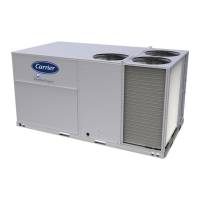48
Fig. 23 — OAT Thermistor Mounting
THERMISTOR/TEMPERATURE SENSOR CHECK
A digital volt-ohmmeter is required to perform this check.
Connect the digital volt-ohmmeter across the appropriate
thermistor terminals at the J8 connector on the Main Base
Board (see Major System Components).
Using the voltage reading obtained, read the sensor tempera-
ture from Table 24 on page 49.
To check thermistor accuracy, measure temperature at probe
location with an accurate thermocouple-type temperature-mea-
suring instrument. Insulate thermocouple to avoid ambient
temperatures from influencing reading. Temperature measured
by thermocouple and temperature determined from thermistor
voltage reading should be close, within 5°F if care was taken in
applying thermocouple and taking readings.
If a more accurate check is required, unit must be shut down and
thermistor removed and checked at a known temperature (freezing
point or boiling point of water) using either voltage drop measured
across thermistor at the J8 connector, or by determining the resis-
tance with unit shut down and thermistor disconnected from J8.
Compare the values determined with the value read by the control
in the Temperatures mode using the SystemVu™ display.
Sensor Trim
Corrective offsets can be applied to all the analog inputs. Trim
can be used as a form of calibration. The trim works by adding
or subtracting the specified amount on the specified analog in-
put. These corrections should only be use when a proper cali-
brated tool is used to compare to the sensors reading. These
corrections are only applied to the local sensor values, a build-
ing systems (BAS) communicating values will not account for
these corrections. Use the SERVICE CALIBRATION
menu on the SystemVu Display to adjust these values.
Transducer Troubleshooting
The electronic control uses suction and discharge pressure
transducers to measure the pressure of the refrigerant circuits.
The pressure/voltage characteristics of these transducers are in
shown in Table 25 on page 51 for suction transducers and
Table 26 on page 52 for discharge transducers. The 5vdc power
is applied to legs A and B of the transducer and legs B to C rep-
resent the signal voltage. To use Table 25 on page 51 for trou-
bleshooting, read the voltage across A and B, then subtract the
voltage reading from B to C. The voltage drop can be looked
up in Table 25 and Table 26 depending on the type of transduc-
er. The accuracy of these transducers can be verified by con-
necting an accurate pressure gage to the second refrigerant port
in the suction and discharge lines.
MAJOR SYSTEM COMPONENTS
General
The 48/50LC single package rooftop units are available with
the factory-installed optional SystemVu electronic control sys-
tem that monitors all operations of the rooftop. The control
system is composed of several main control components and
available factory-installed options or field-installed accessories
as listed in sections below. See Fig. 24-35 for examples of typ-
ical control and power schematics for 48/50LC units.

